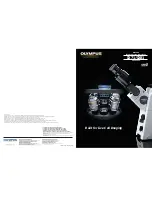
4
8. SAFETY RACK STOP: When properly adjusted, controls maximum upward travel of stage. Prevents higher
power objectives from breaking specimen slides, prevents damage to objective lenses. This stop has been pre-
adjusted at the factory.
9. FOCUSING KNOBS: Coarse focusing knobs (larger knobs) located on each side of arm, raise or lower stage to
bring specimen image into focus. Fine focus knobs (smaller knobs located just below coarse focusing knobs)
permit more precise image adjustment.
10. ILLUMINATION: Built-in substage electric illuminator provides constant, reliable pre-focused illumination.
Observe that the main voltage of your microscope is labeled on the back of the base. Make certain that
the main voltage of your microscope corresponds to the voltage of your power outlet, 120v or AC.
OPERATION
1. Illumination.
A.
Insert microscope plug into outlet.
B. Push rocker switch at rear of base to ON position.
C. In case of equipment malfunction, see “Trouble Shooting” procedures.
2. For model 157 binocular head only, interpupillary adjustment of viewing head
A. Look through microscope and adjust distance between the two eyepiece tubes by grasping the sliding
mounts to left and right of eyepieces and sliding together or apart.
B. When a full field of view is observed through both tubes, and images blend into one, interpupillary distance
is corrected for your eyes. Check the interpupillary scale and note index reading for future reference, in
case other users will be changing this adjustment from time to time.
C. Adjust the diopter scales, located on each eyepiece tube, to the same numerical value as indicated on the
interpupillary scale. This must be done in order to maintain parfocality of objective lenses. If interpupillary
distance is changed, adjust eyepiece diopters accordingly.
3. Focusing the microscope.
A. Position the 4x objective lens into the optical path, making sure that lens is properly indexed in its click-stop
position.
B. Swing moveable finger on slide holder outward. Place specimen slide (cover slip up) on top of stage
surface against fixed side of slide holder. Slowly release moveable finger until it makes contact with
specimen slide.
C. Rotate coarse focusing controls until specimen comes into focus.
D. Adjust fine focus controls until specimen is in sharp focus.
E. For model 157 binocular head only, adjust diopter for possible difference in eyesight between user’s left and
right eyes. If user has 20/20 vision, this adjustment should not be necessary.
a) Using right eye, peer into the right eyepiece tube. Adjust sharpness of image by utilizing fine focus
controls, without touching the diopter ring.
b) Using left eye, peer into the left eyepiece tube. Adjust sharpness of image by turning diopter
adjustment located on left eyepiece tube.
F. Adjusting the aperture (opening) of iris diaphragm.

























